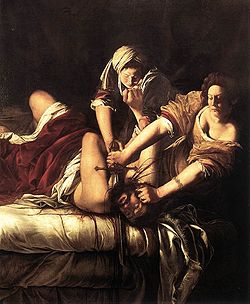
Elizabeth Sirani was an artist that addressed problems in society. She was daughter to an artist and believed to be a fraud. This lead Sirani "to prove the wags wrong, she gain painting in public. (Guerrilla Girls 30)." She was a woman that was unafraid to confront those who spoke out against her, so much so that she painted Portia wounding her thigh. This painting tells the story of a woman who had courage, the same amount or even more than a man. She was trying to prove her love to a man, as well as show the world that all women are not weak or impossible to trust. Sirani was sending out a message that was powerful and strong to those around her, one that lasted throughout the ages.
While Sirani was addressing current issues and outlooks on women, Artemisia Gentileschi was trying to break down the contempt the world had for women who had been raped. She was a young aspiring artist who portrayed Susanna and the Elders in a way no else had. Gentileschi showed in her art that women can also have "action" in art. That not all transgressions have been asked for, and that women are not vain, and waiting for men to observe them day and night. She took the normally placed blame from an innocent woman and placed it onto men, who were supposed to be responsible, protective gentlemen. She did this again when she painted Judith and the maidservant. She showed strong independent women committing an act that was, then considered out of the realm of possibility for women. She proved in her artwork that women could equal men in brutality. The world may have been shocked by this then but not today.
Speaking of action, Camille Claudel was a woman who was willing to act in sculpture. She bared her body as well as her soul in her artwork, and the work of her lover Auguste Rodin. She lived her life openly and publicly. Claudel and Rodin's art "expressed an overt sexuality." Everyone knew of her relationship with Rodin and deemed her and her work as "shocking and indecent, (Guerilla Girls 57)." Rodin on the other hand was praised for the work he created and gained much popularity. Claudel created some of her best work during this time but lost commissions because she chose to work in a "man's field," a place where no woman should tread. She eventually was committed to an insane asylum for believing she could ever make art that shocked the public.Her art spoke volumes of sexuality and so she was cut off from society.
Shock goes hand in hand with Judy Chicago. She was an artist that was restricted to women in her education. This enabled her to view her body and the body of women in general as art. She created "The Dinner Party"an artwork that placed representations of women's vaginas onto dinner plates. She created art that was seen as vulgar and many political figures wanted her art to be deemed pornographic and lacking in discretion.
When a lack of discretion is mentioned the Guerrilla Girls must follow. These mysterious women verbally and pictorially attack any misconceptions on or lack of women in art history. Their work covers the taboos all throughout history. Their artwork focuses on the oppression of women in the field of art. The art that should be equally displayed in museums. These Guerrilla Girls are the most openly disgruntled people but not the only ones who have shown a dislike of society and their outlook on women and their place. The Guerrilla Girls are giving a blatant voice to the underrepresented women artist not only of the world but of history.
These artists all focused on being true to themselves, whether or not society liked it. They all hinted at or called out the discriminations against women and the oppression that women faced. These women were unafraid to do what they loved and to do it so well that society thought they cheated here and there along the way. There are artists today that can be seen doing similar things as these women in their art. Some examples can be seen at our local museum.
Works Cited:
Chadwick, Whitney. Women, Art, and Society. 3rd ed. New York, NY: Thames and Hudson, 2002.
The Guerrilla Girls' Bedside Companion to the History of Western Art. New York: Penguin, 1998. Print


.jpg)


No comments:
Post a Comment